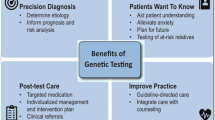Abstract
Familial hypercholesterolemia (FH) (OMIM 143890) is an autosomal dominantly inherited disease mainly caused by mutations of the gene encoding the low density lipoprotein receptor (LDLR) and Apolipoprotein (Apo) B. First the common mutation R3500Q in ApoB gene was determined using PCR/RFLP method. Then the LDLR gene was screened for mutations using Touch-down PCR, SSCP and sequencing techniques. Furthermore, the secondary structure of the LDLR protein was predicted with ANTHEPROT5.0. The R3500Q mutation was absent in these two families. A heterozygous p.W483X mutation of LDLR gene was identified in family A which caused a premature stop codon, while a homozygous mutation p.A627T was found in family B. The predicted secondary structures of the mutant LDLR were altered. We identified two known mutations (p.W483X, p.A627T) of the LDLR gene in two Chinese FH families respectively.





Similar content being viewed by others
References
Sozen M, Whittall R, Humphries SE (2004) Mutation detection in patients with familial hypercholesterolaemia using heteroduplex and single strand conformation polymorphism analysis by capillary electrophoresis. Atheroscler Suppl 5(5):7–11
Jelassi A, Najah M, Jguirim I et al (2008) A novel splice site mutation of the LDL receptor gene in a Tunisian hypercholesterolemic family. Clin Chim Acta 392(1–2):25–29
Pandit S, Wisniewski D, Santoro JC et al (2008) Functional analysis of sites within PCSK9 responsible for hypercholesterolemia. J Lipid Res 49(6):1333–1343
Bourbon M, Alves AC, Medeiros AM et al (2008) Familial hypercholesterolaemia in Portugal. Atherosclerosis 196(2):633–642
Austin MA, Hutter CM, Zimmern RL et al (2004) Genetic causes of monogenic heterozygous familial hypercholesterolemia: A HuGE prevalence review. Am J Epidemiol 160(5):407–420
Halloran P, Pisani T, Long S (1997) A homogeneous assay for the direct measurement of LDL-cholesterol in serum. Clin Chem 43:254–258
Loparev VN, Cartas MA, Monken CE et al (1991) An efficient and simple method of DNA extrac- tion from whole blood and cell line to identify infectious agents. J Virol Methods 34(1):105
Hansen PS, Rüdiger N, Tybjaerg-Hansen A et al (1991) Detection of the apoB–3500 mutation (gluta- mine for arginine) by gene amplification and cleavage with MspI. J Lipid Res 32(7):1229–1233
Wang LY, Cao SC, Lin J et al (2003) Application of Touch-down PCR technique in the research of detecting gene point mutation in LDL-R gene. Chin J Lab Med 26(7):403–406
Geisel J, Walz T, Bodis M et al (1999) Fluorescence-based single-strand conformation polymorphism analysis of the low density lipoprotein receptor gene by capillary electrophoresis. J Chromatogr B Biomed Sci Appl 724(2):239–247
Yan M, Xiong C, Ye SQ et al (2008) A novel connexin 50 (GJA8) mutation in a Chinese family with a dominant congenital pulverulent nuclear cataract. Mol Vis 14:418–424
Deleage G, Combet C, Blanchet C et al (2001) ANTHEPROT: an integrated protein sequence analysis software with client/server capabilities. Comput Biol Med 31(4):259–267
Deleage G, Clerc FF, Roux B (1989) ANTHEPROT—IBM PC and APPLE MACINTOSH Versions. Comput Appl Biosci 5(2):159–160
Deleage G, Clerc FF, Roux B et al (1988) ANTHEPROT: a package for protein sequence analysis using a microcomputer. Comput Appl Biosci 3:351–356
Leigh SE, Foster AH, Whittall RA et al (2008) Update and analysis of the university college London low density lipoprotein receptor familial hypercholesterolemia database. Ann Hum Genet. Mar 3 [Epub ahead of print]
Mak YT, Pang CP, Tomlinson B et al (1998) Mutations in the low-density lipoprotein receptor gene in Chinese familial hypercholesterolemia patients. Arterioscler Thromb Vasc Biol 18(10):1600–1605
Hobbs HH, Russell DW, Brown MS et al (1990) The LDL receptor locus in familial hypercholesterolemia: mutational analysis of a membrane protein. Annu Rev Genet 24:133–170
Chang JH, Pan JP, Tai DY et al (2003) Identification and characterization of LDL receptor gene mutations in hyperlipidemic Chinese. J Lipid Res 44(10):1850–1858
Pimstone SN, Sun XM, du Souich C et al (1998) Phenotypic variation in heterozygous familial hypercholesterolemia: a comparison of Chinese patients with the same or similar mutations in the LDL receptor gene in China or Canada. Arterioscler Thromb Vasc Biol 18(2):309–315
Sun XM, Patel DD, Webb JC et al (1994) Familial hypercholesterolemia in China. Identification of mutations in the LDL-receptor gene that result in a receptor-negative phenotype. Arterioscler Thromb Vasc Biol 14(1):85–94
Davis CG, Goldstein JL, Anderson RG et al (1987) Acid dependent ligand dissociation and recycling of LDL receptor mediated by growth factor homology region. Nature 326:760–765
Acknowledgement
We thank the family members for their participation in this study. This work was supported by the New Century Scholarship (NCET-05-0621), Funds for Outstanding Youth in Hubei Province (2006ABB009) and Funds for Creative Research Group (No 20621502), NSFC.
Author information
Authors and Affiliations
Corresponding author
Additional information
X. Cheng and J. Ding have contributed equally to this work.
Rights and permissions
About this article
Cite this article
Cheng, X., Ding, J., Zheng, F. et al. Two mutations in LDLR gene were found in two Chinese families with familial hypercholesterolemia. Mol Biol Rep 36, 2053–2057 (2009). https://doi.org/10.1007/s11033-008-9416-z
Received:
Accepted:
Published:
Issue Date:
DOI: https://doi.org/10.1007/s11033-008-9416-z




